Via QuarkNet, UT Physics Links Area High Schools with Particle Physics Research
What started out as personal networking between UT physics and area teachers has led to literal networking—sharing datasets and online activities—all in the interest of connecting high schools with big-league science.
Kranti Gunthoti is a UT physics lecturer who’s also deeply involved in outreach, particularly working with East Tennessee schools. He’s encouraging students to pursue science careers, as well as building a conduit between the community and the university through programs like Saturday Morning Physics. It was on a visit to West High School in Knoxville that he and Assistant Professor Sowjanya Gollapinni presented Tommy Eggleston, a physics and math teacher, with an additional opportunity.
“They came to my class to talk to my students about physics and physics careers,” Eggleston said. “Sowjanya brought up QuarkNet.”
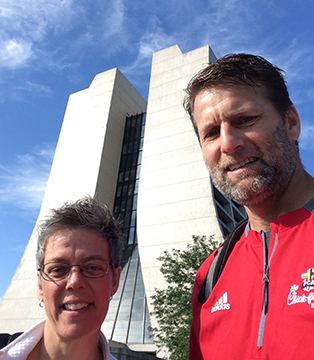
Johnson and Eggleston at Fermilab, where they attended data camp as part of their QuarkNet training.
QuarkNet is an outreach program managed by FermiLab, a national particle physics and accelerator lab in Batavia, Illinois, and the University of Notre Dame. The goal is to connect high school students and teachers with physicists on projects exploring the hidden nature of matter, energy, space, and time. Gollapinni’s research is based at Fermilab and, like Gunthoti, she has a passionate interest in outreach. Eggleston said he had been looking for a way to get involved with UT, and QuarkNet was a great opening.
Networking also brought Erica Johnson (MS, UT Physics, 2009) to the project. She’s a physics and chemistry teacher at Halls High School who found out about the program from Joe Foy of Knoxville’s L&N STEM Academy. QuarkNet is the sort of initiative she knows well: as a master’s candidate she taught high school students in Fentress County through a distance education project based at UT.
Eggleston and Johnson each receive a summer stipend for eight weeks: seven on the UT campus and one at Fermilab for “data camp,” which Gollapinni described as a kind of boot camp for particle physics. Teachers dive into particle physics data and work through activities to get a picture of how scientists make discoveries in this kind of major experimental environment.
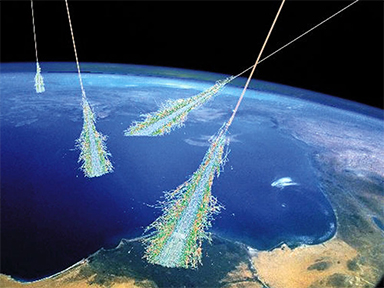
Cosmic rays (image credit: NASA)
On campus, they’re looking at the properties of cosmic rays—high-energy particles that make their way to Earth from space. Most are protons, but when they collide with other particles in Earth’s upper atmosphere, they create new particles (most of which are called pions), which decay and emit muons in the process. Eggleston explained that QuarkNet looks at three different aspects of physics: flux (muons per square meter per second); time-of-flight (calculating muon speeds); and lifetime studies (how long it takes a muon to decay). He and Johnson built cosmic ray detectors, with an e-lab component where they can upload data to a shared portal along with QuarkNet projects at other schools across the country. They’ll have access to online learning materials and can keep up with other teachers and QuarkNet staff through an e-mail listserv.
Eggleston and Johnson are camping out in Gollapinni’s lab space in the Science and Engineering Research Facility on the Hill, where they built their detectors using scintillator material and photomultiplier tubes; devices that detect light. When a cosmic muon hits the scintillator, the latter absorbs the muon’s energy and re-emits it in the form of light, which is then detected by the photomultiplier tubes. The light signals are then read out by a data acquisition board that sends the collected data to a specialized software for data analysis, something Johnson and Eggleston are spending a lot of time on.
“At first glance, it doesn’t seem very exciting,” Johnson said, sitting in front of a computer screen displaying graphs. “But there’s a lot to it.”
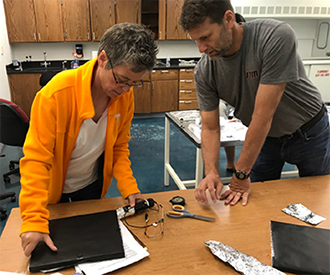
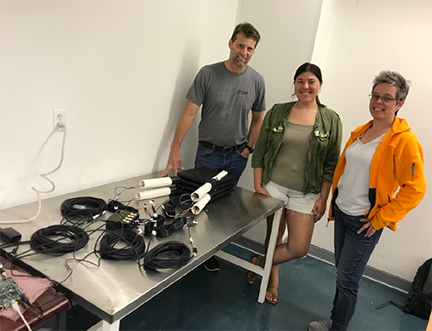
Johnson and Eggleston built cosmic ray detectors for Halls and West High Schools, with help from undergraduate physics major Tara Skiba (right, center). Image credit: Kranti Gunthoti.
As a physics and math teacher, Eggleston is looking forward to incorporating statistical analysis of data into his teaching. He teaches IB (International Baccalaureate) Physics, and explained that while the first year involves mechanics and a lot of hands-on learning, the second year gets into particle and atomic physics. He said he wants to bring some interest and an added dimension to that as well. Teaching is a second career for him after 25 years of making furniture, so he’s learning along with his students.
“The primary reason I’m here is because I don’t know this stuff,” he said. “We’re building things on the fly. We’re turning over rocks.”
As problem-solving is a key part of a scientific education, Johnson said there’s a push to integrate science and engineering. QuarkNet is a nice example of both experiment building and data analysis.
“It allows students to fine tune their science skills,” she said.
Both teachers are also learning more about particle physics and neutrino research related to Fermilab’s MicroBooNE experiment, with which Gollapinni is deeply involved. They’re learning to use cosmic muon data collected by the experiment and measure the purity of liquid argon, a cryogenic ultra-cold liquid (-186 °C) used as a nuclear medium for particles to interact in the MicroBooNE steel cryostat. MicroBooNE’s primary purpose is to study fundamental particles called neutrinos, trillions of which pass unfelt through our bodies every second. Keeping the liquid argon ultra-pure (free of contaminants like oxygen, water or nitrogen) is crucial to studying the data collected by MicroBooNE, as impure argon can degrade the signals left by particles.
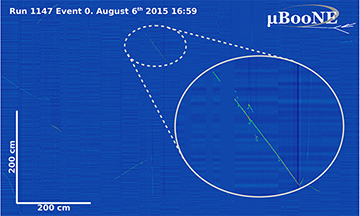
Some of the first images of cosmic rays and UV laser tracks recorded by the MicroBooNE experiment (image credit: MicroBooNE)
Gollapinni explained that at the close of the summer Eggleston and Johnson will share their experiences with their students and other teachers.
“They will also take the cosmic ray detectors to their schools and start getting students involved in the project,” she said. “The goal is to include it in the curriculum in some form. Kranti and I will continue to make visits to West and Halls (and many new comers) during the academic year to keep in touch and to give talks on research. The teachers will continue to spend a small portion of their time on the MicroBooNE related neutrino research during the academic year since they are trained now.”
The QuarkNet model also allows for program expansion over time. Once they learn the ropes, Eggleston said he and Johnson will “become in a sense ambassadors to other students and their teachers.”
Gollapinni, UT’s principal investigator on QuarkNet, will coordinate funding resources and recruit up to 10 new teachers for the program next year, with Johnson and Eggleston leading a three-week workshop. In the third year they’ll bring in students along with teachers—all of whom will spend time on campus. She plans to reach out to schools in Knox and surrounding counties, especially Title 1 schools.
“Title 1 schools are more diverse, and we plan to reach out to kids from underserved and poor communities,” she explained. “We are strategizing the best way to reach out and motivate them to take part in research opportunities at UT.”
For Gollapinni and Gunthoti, husband-and-wife physicists raising two young children, recruiting new teachers means many school visits, something they’re happy to do to spark interest in physics. For Johnson and Eggleston, being at the forefront of UT’s QuarkNet involvement means not only linking their schools with the university and national research initiatives, but also bringing them back to the science they pursued as students.
“This is renewing my love for it,” Eggleston said.